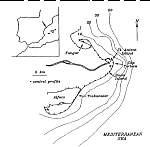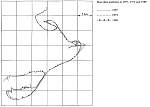Chapter 5: Large Projects
5.5 The Ebro Delta Project (Spain) (1)

| European Coasts - An Introductory Survey Chapter 5: Large Projects 5.5 The Ebro Delta Project (Spain) (1) |
|
 |
 |
 |
| Fig 129: The Ebro Delta (Spain) | Fig 130: Main dams in the Ebro river basin | Fig 131: Shoreline positions in 1957, 1973 and 1989 |
The Ebro Delta is located 150 km south-west of Barcelona. It is a medium-sized delta; the seaward perimeter is about 50 km long and consists of sandy beaches. The main morphological features are the two spits, the -central lobe and the two lagoons (see Fig. 129).
The centuries of continuous natural growth of the delta have taken place because of the continuous supply of
sand (and silt) from the river Ebro. However, during the last half of this century the supply of sand has reduced
dramatically. Construction of dams upstream (see Fig. 130), flow regulation and rainfall decrease have all contributed to this change in conditions. Today's sand input from the river is estimated at 30,000
m3 per year; in former times the input was over 500,000 m3 per year (Callis et al., 1988). Such a large change in the natural
input conditions has resulted in a response in the river-delta system (see Fig. 131). The central lobe area (Cap
Tortosa; see Fig. 129) has eroded more than 1,500 m in the last 30 years. While the central lobe area is severely eroding, the northern and southern spits are still advancing: 1,000 m and 700 m, respectively, in the
last 30 years. They do not "know" yet that the input -from the river has been so dramatically reduced. Furthermore, the inner side of the northern spit has also 'i-"own significantly with the help of locally generated
waves.
The delta appears, at present, to be a closed system for the sand fraction. The sandy coastal fringe is fully surrounded by a mud belt (sediment smaller than 63 mm) which indicates there is no sand exchange between the deltaic coast and the mainland. The mud belt starts in a water depth of about 12 m.
previous page table of contents next page
| This page is from the book "European Coasts", produced in the framework of the Erasmus project under EC contract ICP 92-G-2013 and placed on the Internet in the framework of the PIANC-MarCom initiative on Education. |